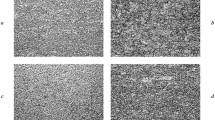Abstract
Theoretical prerequisites and experimental results of a study of the effect of minority melt components, the thermophysical characteristics of the atoms of which differ substantially from those of iron, on the formation of the primary cast structure and properties of articles from structural steels are considered. The effect of these components is shown to have a nonadditive threshold nature.
Similar content being viewed by others
References
V. S. Dub, A Study of the Effect of Deoxidizing by Silicon and Aluminum on the Properties of High-Alloy Steels of Austenitic Class, Author’s Abstract of Candidate’s Thesis [in Russian], TsNIITMASh, Moscow (1966).
S. A. Iodkovskii, Some Theoretical and Technological Problems of Refining of High-Alloy Steels, Author’s Abstract of Candidate’s Thesis [in Russian], TsNIITMASh, Moscow (1970).
L. N. Belyanchikov, “Evaluation of the content of harmful impurities in metal in terms of their effect on the service properties,” Élektrometallurgiya, No. 6, 34–39 (2005).
M. A. Shtremel’, “Solved and unsolved problems of the physics of fracture,” in: Scientific Schools of the Moscow Institute for Steel and Alloys: 75th Anniversary [in Russian], MISiS, Moscow (1997), pp. 392–397.
Yu. I. Ustinovshchikov and O. A. Bannykh, The Nature of Temper Brittleness of Steels [in Russian], Nauka, Moscow (1984).
A. V. Dub, Physicochemical Principles and Control of the Processes of Formation of Primary Structure and of the Set of Service Properties Of Low-Alloy Steels, Author’s Abstract of Candidate’s Thesis [in Russian], MISiS, Moscow (2000).
B. Chalmers, The Theory of Hardening [Russian translation], Metallurgiya, Moscow (1968).
V. S. Dub, A Study of Eccentric Segregation and Development of Methods for Suppressing Its Evolution in Large Ingots, Author’s Abstract of Candidate’s Thesis [in Russian], TsNIITMASh, Moscow (1980).
M. P. Seah, “Segregation and strength of grain boundaries,” Proc. Roy. Soc. London A, 349(9), 785–789 (1976).
R. Cahn (ed.), Physical Metallurgy, Amsterdam (1965).
É. L. Éfros, The Physics of Disorder [in Russian], Nauka, Moscow (1978).
I. A. Krasnoslobodtsev, Effect of Deoxidation of Steel on Chemical Heterogeneity, Author’s Abstract of Candidate’s Thesis [in Russian], TsNIITMASh, Moscow (1991).
E. V. Makarycheva, V. S. Dub, and É. Yu. Kolpishon, “Special features of hardening of superpure steel,” in: Proc. Fourth Congr. of Steelmakers [in Russian], Moscow (1997), pp. 380–383.
A. A. Zhukhovitskii and L. A. Shvartsman, Physical Chemistry [in Russian], Metallurgiya, Moscow (1968).
V. I. Yavoiskii, V. P. Luzgin, and A. F. Vishkarev, Oxidation of Steel and Methods for Its Control [in Russian], Metallurgiya, Moscow (1970).
E. Gudremon, Special Steels [Russian translation], Metallurgiya, Moscow (1966).
B. A. Movchan, Boundaries of Crystallites in Cast Metallic Alloys [in Russian], Tekhnika, Kiev (1970).
E. D. Hondros, “The influence of P in dilute solid solution on the absolute surface and grain boundary energies of iron,” Proc. Roy. Soc. London A, 286(1404), 479–498 (1965).
V. G. Kudin, “Analysis of failures of drilling and oil field equipment used in West Siberia,” in: Operating Capacity of Equipment under Conditions of Low Climatic Temperatures [in Russian], Yakut. Fil. SO Akad. Nauk SSSR, Yakutsk (1978), pp. 34–43.
E. V. Makarycheva, Effect of Deoxidizers and Impurities on the Cast Structure and Properties of Chromium-Nickel-Molybdenum Steels and Choice of Methods For Controlling the Quality of Large Ingots For Forgings, Author’s Abstract of Candidate’s Thesis [in Russian], TsNIITMASh (2003).
M. F. Sidorenko, Theory and Practice of Powder Blasting of Metals [in Russian], Metallurgiya, Moscow (1973).
R. Tarmann, “Die Vakuum-Kohlenstoff-Desoxidation und ihre Auswirkunger bei großen Schmiedestücken aus NiCrMoV-Vergütungsstählen,” Berg-und Hüttenmännische Monotshefte, 123(11), 390–397 (1978).
T. Fukuda, Y. Tanaka, Y. Ideka, and H. Yoshida, “Production and properties of large sized superclean LP turbine rotor forgings,” in: The 13th Int. Forgemasters Meeting, Pussan, Korea, Oct. 12–16 (1997), pp. 429–438.
Yu. I. Matrosov, D. A. Litvinenko, and S. A. Golovanenko, Steel for Delivery Pipelines [in Russian], Metallurgiya, Moscow (1989).
A. Warren and G. S. Ubhy, “Dependence of the microstructure and properties of tube steel of class Kh70 with 0.45% V on the production process,” in: Steels for Gas Delivery Pipes and Fittings, Proc. Conf. [in Russian], Metallurgiya, Moscow (1985), pp. 117–126.
H. N. Lander, “Development of the hot-rolled steel of class Kh80 for 19-mm thick tubes,” in: Steels for Gas Delivery Pipes and Fittings, Proc. Conf. [in Russian], Metallurgiya, Moscow (1985), pp. 126–169.
H. Otoni and T. Hashimoto, “Development of high-strength steels for tubes of class Kh70-Kh100,” in: Steels for Gas Delivery Pipes and Fittings, Proc. Conf. [in Russian], Metallurgiya, Moscow (1985), pp. 170–184.
Author information
Authors and Affiliations
Additional information
__________
Translated from Metallovedenie i Termicheskaya Obrabotka Metallov, No. 7, pp. 7–14, July, 2006.
Rights and permissions
About this article
Cite this article
Dub, V.S., Dub, A.V. & Makarycheva, E.V. Role of impurity and process elements in the formation of structure and properties of structural steels. Met Sci Heat Treat 48, 279–286 (2006). https://doi.org/10.1007/s11041-006-0085-z
Issue Date:
DOI: https://doi.org/10.1007/s11041-006-0085-z




